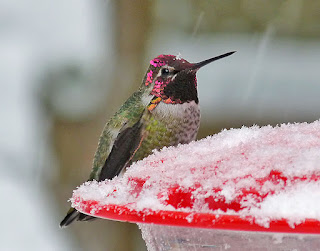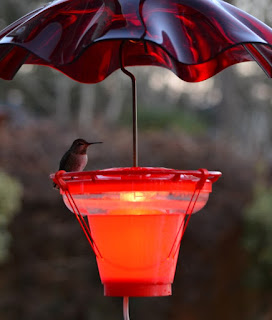What a tough time it was for all the birds when the snow began to fall, covering their many sources of food, but the one bird we had the most inquires about was the Anna’s Hummingbird. It is a sight to see a small fragile little bird like a hummingbird zips past the window when there is a foot of snow on the ground, but they are tough and have survived cold winters before.
A common question when a hummingbird is
seen in the winter months is, what is this bird doing here, shouldn’t it have
migrated south? No, the Anna’s Hummingbird is a non migratory bird so they do
not fly south and we get to enjoy hummingbirds all year long.
I believe that the sightings of the Anna’s
Hummingbird in the Nanaimo area was in the early 70’s and were seen in the
Stephenson Point and Sherwood Forest area. Usually the hummingbirds are seen
along the waterfront where the climate is a bit warmer but over the years as
the population has grown we have received reports of Anna’s Hummingbirds from
many new areas of
It is amazing how a tiny and fragile bird
can survive the winter, they need to consume a lot of nutrients to survive.
Nectar or sugar water has no nutritional value but it provides energy for the
hummingbirds while they find other food like small soft-bodied bugs, and tree
sap for their nutrients. Sometimes you may even see a hummingbird at a spider’s
web, picking small insects out of it. Since the hummingbirds are burning so
many calories they feed on nectar or sugar water every 10 to 20 minutes to keep
them going. Each hummingbird will consume their weight in nectar, which is
roughly 3 grams. A human with the same high metabolic rate would have to
consume twice their body weight or about 150,000 calories, if they were to do
what a hummingbird does each day. Hummingbirds use so much energy, in normal
flight a hummingbird beats its wings 53 times per second to a maximum of 80
beats per second. Their wings can rotate one hundred and eighty degrees and
move in a figure eight pattern, allowing them to move forward, backwards, up,
down and hover like a helicopter. With all this work their heart rate is
approximately 1250 beats per minute.
During the winter there are not many nectar
providing flowers around for the hummingbirds to feed on, so hummingbirds will
depend on the hummingbird feeders through the winter months. The sugar water
solution I use in my hummingbird feeder is one (1) part sugar to three (3)
parts water. Use only white table sugar when making your nectar mix, do not use
honey, as this is fatal to hummingbirds. Also do not use any red food
colouring, as this is also bad for the hummingbirds and not necessarily needed.
Your feeders will need to be cleaned on a regular basis still and always keep
the mixture fresh. The Anna’s Hummingbirds arrive early each morning, around
seven o’clock, to get their boost of energy to start the day and a cold drink
on a cold day does not go down well. Bring your feeders at night, at dark, this
will keep the sugar water from freezing and warm it up to room temperature
which will give the hummingbirds a good start to a cold morning. If your feeder
freezes during the day, have a second feeder available to replace it with while
the other thaws out. To keep things really warm place your hummingbird feeder
below a light bulb or heat lamp to keep it from freezing. During the real cold
of winter it may also be necessary to remove the perches from your hummingbird
feeder. This will make the hummingbirds hover to feed and the movement will
keep their body temperature up.
During the day hummingbirds are constantly
looking for food to survive the cold nights. Then at night hummingbirds have to
find a place to roost, that is out of the wind and protected from rain and snow.
This may be in shrubs and evergreen trees or in a corner next to the house or a
window. Our neighbours were lucky to have a couple of hummingbirds roost in
their greenhouse to escape the elements. For a hummingbird it is tough to keep
warm especially since they do not have any down feathers, so at night to
conserve energy a hummingbird will go into a hypothermic stat known as torpor.
This internal mechanism hummingbird will slow and lower their body temperature
and metabolic rate so the hummingbird can conserve enough energy to survive the
night and a little extra to start the morning.
Hummingbirds are such amazing little
creatures and we have the privilege of enjoying them all year round. In less
than three months the Rufous Hummingbirds will be returning, a sign of spring.
Here are some additional tips to help keep your hummingbird nectar from freezing:
- Incandescent lights are your best friend. If you can find a string of incandescent Christmas lights you can wrap them around the hummingbird feeders to limit freezing. If you have a mechanic's trouble light you can put an incandescent bulb in it and point it at the feeder to provide heat.
- Insulation against the wind helps limit freezing. Some customer's have used old wool socks, bubble wrap, towels, etc. wrapped around the hummingbird feeder to help limit the chill and provide some insulation. This method works even better if you're able to add some hand warmer packets against the bottle.
- Swapping out hummingbird feeders (e.g. one outside while one is inside thawing). This method can require swapping every hour depending on how cold it is. When thawing out your hummingbird feeder please ensure you have "mixed" the solution prior to putting it back outside as the solution can experience separation when frozen (e.g. you will see two layers- one sugar concentrated solution on the bottom and a watery layer on the top).
- Commercial hummingbird feeder heaters. These electric devices are very convenient and often contain a low wattage incandescent bulb and a way to affix the heater to your feeder (some heaters may come with a pre-attached feeder).
- Domes and other overhead cover can help retain heat around your hummingbird feeder.





Some great information in this article. However, anything I've read from reputable sources advises never to use more than a 1 portion sugar to 4 parts water ratio as it can be dangerous for hummingbirds.
ReplyDelete